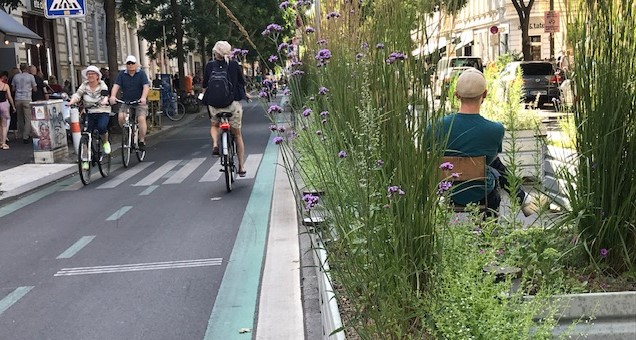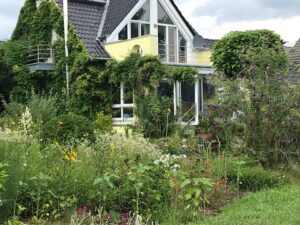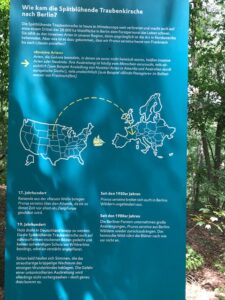We Wild Ones feel virtuous about our commitment to native plants, and rightly so. But we rarely ask ourselves how our plants are received in other parts of the world. During my annual trips to Germany, I often come across familiar north American species and I begin to muse about the benefits and problems of human induced plant migrations. This summer, my husband and I rented an Airbnb in Berlin near the Bergmannstrasse, a busy street lined with shops and restaurants. Two blocks had recently been radically traffic-calmed. The street was divided into 3 lanes: one lane was open to bicycles going in both directions, another lane accommodated one-way traffic for deliveries and persons who lived there. The middle lane was given over to casual seating with chairs and benches surrounded by attractive metal containers from which tall plants sprouted looking both natural and pretty. Among the plants was our purple Verbena bonariensis. I was delighted to find this friend from home lending such grace to an imaginatively designed urban setting. The two blocks along this busy street accommodated movement, car-ownership, pedestrian traffic and Berliners’ ever-present need to take a break, to have a drink, to just sit, take in the sun, to observe the lively urban hubbub around, to fiddle with their phone or read a book. I like to think that the Berliners who shop or dine or simply hang out in the Bergmannstrasse, feel a warm welcome for this pretty though not very showy flower from our part of the world. More likely, though, they are pretty indifferent to the plant’s geographic origin. If so, that indifference seems not so casually extended to people from elsewhere. While the new plant containers were still free of the ubiquitous Berlin graffiti, one of them had already been adorned with this message: “Tourists go home!”
I like to think that the Berliners who shop or dine or simply hang out in the Bergmannstrasse, feel a warm welcome for this pretty though not very showy flower from our part of the world. More likely, though, they are pretty indifferent to the plant’s geographic origin. If so, that indifference seems not so casually extended to people from elsewhere. While the new plant containers were still free of the ubiquitous Berlin graffiti, one of them had already been adorned with this message: “Tourists go home!”

Everywhere in Germany I found a vine whose leaves were formed by five palmately arranged leaflets. In gardens it climbed on fences and walls and in urban parks it climbed on trees and lampposts. I asked a landscape architect what it is called in German. Oh, he said, that is a wild vine; which is the name Germans will assign to any climbing plant that doesn’t make grapes and whose name they don’t know. But, on reflection, he came forth with a more precise definition: Parthenocissus quinquefolia. Of course, I already knew that it was Virginia Creeper (but I still don’t know its German name, since the “wild vine” is firmly settled in people’s horticultural vocabulary). It covers all manner of surfaces adding much needed green in urban spaces that can overwhelm with concrete and brick. It is a north American native that has found a welcoming home in Germany. Not so our native wild cherry (Prunus serrotina), which was introduced to Europe in the 17th century. Its lustrous dark green leaves and white flowers born on pendulous racemes and followed by red fruit that turn black during summer recommended it as a desirable ornamental. While we cherish it as a host plant for many species of moths and butterflies, in Europe it is pretty much ignored by wildlife, which added to its ornamental value. But now it has become a maligned invasive in natural forests. I visited a state-of-the-art natural restoration display in the Grunewald, Berlin’s largest city forest. Eradicating the “late-flowering grape cherry” as it is called in translation, was a major effort underway in the Grunewald. The sign on the left illustrates the tree’s passage to Europe from North America, seemingly to France from Nebraska. Europeans, of course, had not reached the upper Mississippi in the 17th century, and the tree almost certainly came from somewhere near our east coast. Never mind, the central European climate, not dissimilar to our own, suited it perfectly and it has spread all the way to Russia. Beate Popkin
Not so our native wild cherry (Prunus serrotina), which was introduced to Europe in the 17th century. Its lustrous dark green leaves and white flowers born on pendulous racemes and followed by red fruit that turn black during summer recommended it as a desirable ornamental. While we cherish it as a host plant for many species of moths and butterflies, in Europe it is pretty much ignored by wildlife, which added to its ornamental value. But now it has become a maligned invasive in natural forests. I visited a state-of-the-art natural restoration display in the Grunewald, Berlin’s largest city forest. Eradicating the “late-flowering grape cherry” as it is called in translation, was a major effort underway in the Grunewald. The sign on the left illustrates the tree’s passage to Europe from North America, seemingly to France from Nebraska. Europeans, of course, had not reached the upper Mississippi in the 17th century, and the tree almost certainly came from somewhere near our east coast. Never mind, the central European climate, not dissimilar to our own, suited it perfectly and it has spread all the way to Russia. Beate Popkin
